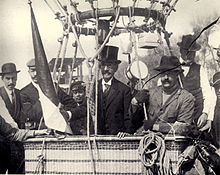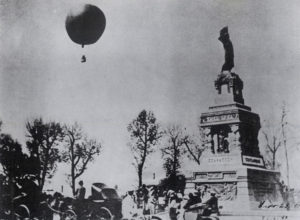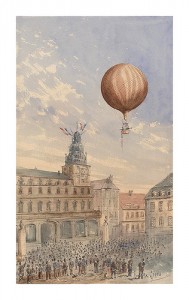INGENIOSOS PERSONAJES CUBANOS:.. “Y VOLÓ COMO MATÍAS PÉREZ..!”
Los globos no fueron conocidos en Cuba hasta el año 1796. La primera excursión aerostática se efectuó en La Habana el 19 de marzo de 1828 como uno de los más atrayentes números del programa de festejos combinado para solemnizar la inauguración del Templete de la Plaza de Armas, bajo el gobierno benéfico pero duro de Don Francisco Dionisio Vives.
Una de las historias más conocidas en Cuba es la de Matías Pérez, un piloto portugués residente en Cuba durante el siglo XIX. Hay motivo para creer que Matías estaba ya aplatanado en Cuba y había constituido familia en esta ciudad.
Matías Pérez se desempeñaba como toldista, es decir, confeccionaba toldos de lona para proteger las casas y establecimientos del fuerte sol, pero sus ratos libres los dedicaba a estudiar aerodinámica, horas dedicadas a desentrañar el misterio de la ligereza del aire. Su anhelo era construir un globo aerostático y elevarse en las alturas. Poco a poco fue confeccionando la barquilla, el quemador, la envoltura y demás aditamentos. Cuando hubo hallado la clave para elevarse, bautizó su globo como “Villa de París”, y se decidió a realizar lo que sería su primera y única ascensión.
El 9 de junio de 1856, el pueblo habanero, se agolpaba en la Plaza de Marte, para presenciar la ascensión de Matías Pérez. El calendario marcaba el 9 de junio de 1856. Se dirigió temprano en la mañana al antiguo Campo Marte, (hoy Parque de la Fraternidad de La Habana), llamado así por ser una explanada escogida para ejercicios militares y por ser Marte el dios de la guerra. Ante las miradas curiosas de desconocidos, amigos y familiares se elevó por los cielos, mientras se escuchaban las voces de… ¡buen viaje Matíaaaaassss!
Dicho y hecho subió y fue a descender a los Filtros del Husillo. Unos días después, el 28 de junio volvió a ascender en su globo ‘la Villa de París’. Nadie supo lo que sintió Matías en ese momento pero es fácil imaginarlo. A poco que el globo se elevaba, la villa parecía más pequeña y los que estaban en tierra vieron como se esfumaba en el cielo de San Cristóbal de La Habana y tan completa, tan magna y tan sobresaliente fue su ascensión que… aún estamos esperando su regreso. Eso se llama subir y lo demás son cuentos.
Nunca más se sabría de él, de su viaje, de sus impresiones y resultado de su sueño. Actualmente Matías es para muchos el primer vestigio de cosmonauta, del innovador.
Consta que se hizo una minuciosa investigación por mar y tierra para dar con el audaz aeronauta o con su cadáver; pero todas las diligencias resultaron infructuosas. Años después, cuéntase que en unos cayos próximos fueron hallados restos de un globo ¿Sería el Villa de París? ¡Quién lo sabe!
Del intrépido aeronauta no ha quedado entre nosotros más que un desvanecido recuerdo. A partir de este acontecimiento, cuando algo o alguien desaparece se suelen utilizar las expresiones ya tradicionales: “se fue a bolina como Matías Pérez” o simplemente, “voló como Matías Pérez”.
INGENIOUS CUBAN CHARACTERS:.. “AND HE FLEW AS MATÍAS PÉREZ…!”
The balloons were not known in Cuba until 1796. The first trip was made aerostatic in Havana on March 19, 1828 as one of the most attractive numbers of the celebration program combined to solemnize the inauguration of the Shrine of the Plaza de Armas, under the rule beneficial but harsh Don Francisco Dionisio Vives .
One of the best known stories in Cuba is that of Matias Pérez, a resident portuguez pilot in Cuba during the nineteenth century. There is reason to believe that Matias was already aplatanado in Cuba and had established family in this city.
Matias Perez served as ‘toldista’, and making canvas awnings to protect homes and establishments in the hot sun, but his spare time he devoted to study aerodynamics, hours devoted to unravel the mystery of the lightness of air. His desire was to build a hot air balloon and soar on high. He gradually putting together the basket, burner, wrapping and other attachments. When he had found the key to rise, baptized his balloon as “City of Paris”, and decided to make what would be his first and only ascent.
On June 9, 1856, the people of Havana, crowded into the Plaza de Marte, to witness the ascension of Matias Perez. The calendar marked the June 9, 1856. He went early in the morning the old Campo Marte (today Fraternity Park Havana), named for an esplanade be chosen for military exercises and being Mars the god of war. Given the curious stares of strangers, friends and family flew through the skies, while listening to the voices of … Matíaaaaassss good trip!
Said and done up and went down to the Spindle filters. A few days later, on June 28 climbed back up in his balloon ‘the City of Paris’. No one knew how it felt at the time but Matthias is easy to imagine. As long as the balloon rose, the town seemed smaller and those on earth were as faded in the sky of San Cristobal de La Habana and so complete, so great and so remarkable was his ascension … we are still waiting for his return. That is called up and the rest are stories.
Never again would know him, his travel, his impressions and result of his dream. Matthew currently is for many the first trace of cosmonaut, the innovator.
It has to be made a thorough investigation by sea and land to make the bold aeronaut or his body, but all steps were unsuccessful. Years later, It is said that in a few keys were found near the remains of a balloon Would the City of Paris? Who knows!
The intrepid aeronaut has not been with us more than a faded memory. From this event, when something or someone disappears expressions are often used traditional and “went as Matías Pérez bowline” or simply “flew like Matias Perez.”
Agencies/Wiki/HavanaInside/Jiribilla/Internet Photos/ Arnoldo Varona/ TheCubanHistory.com
THE CUBAN HISTORY, HOLLYWOOD.











